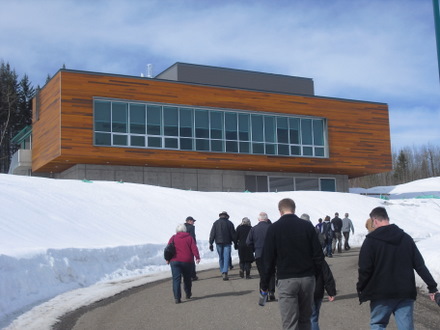The 'Bigger Picture' Of UNBC's Bioenergy Plant

Tour participants go for a first-hand look at the plant following the official opening
Prince George, B.C. - The new bioenergy plant at UNBC will serve a larger purpose than to just reduce the university's carbon footprint - the technology has very real implications for whole communities...
On a busy day, the campus can swell to 5,000 people. UNBC's Assistant Director of Facilities, Doug Carter, points out that's a Mackenzie or a Chetwynd. He says the ground-breaking thermal heating system will act as a model for small communities.
Carter says the university's enhanced forestry lab has been running on wood biomass pellets for almost two years and that data has its own implications. "We probably have enough capacity in that little system to heat a community centre, school or something like that."
"(The bioenergy plant) system is sending down to a central plant which is heating one-million square feet of buildings - and we're talking labs, offices, and everything - and this is a template for a small city, a distributed energy system."
Carter says it's typical of what's already being done in many European communities, where a central plant sends the high temperature water out and instead of having a gas or electrical meter in front of the house, it's an energy meter that measures the hot water going in, the temperature and flow of the water coming out - it will generate a gigajoule number and people are billed for how many gigajoules of hot water they use.
In speaking to a tour group last week, UNBC's Energy Manager, David Claus, pointed out that one of the variables in determining the 'payback' of installing such a system is the cost of labour to maintain it. "It's a bit of an unknown and that's part of the reason we're putting this in," he says. "Right now, if you're a private company and you're putting one of these in - or you're a community - your only option is to go to the vendor and get their information on what it takes and, of course, they're in the business of selling systems."
Claus says, "We don't know, we'll see. We're going to run it for a year or two and then we'll have a better picture of how much extra labour it takes to run it and then that data will be available - it's part of our mandate as a research-intensive university."
The Energy Manager says that's one of the strengths of UNBC - it is always integrating its operations with its research. "The university has taken what it needs to do anyway with its operations and brought its researchers on-board, given them access to the data and worked together - we keep the place warm and we're producing useful data."
Previous Story - Next Story
Return to Home










